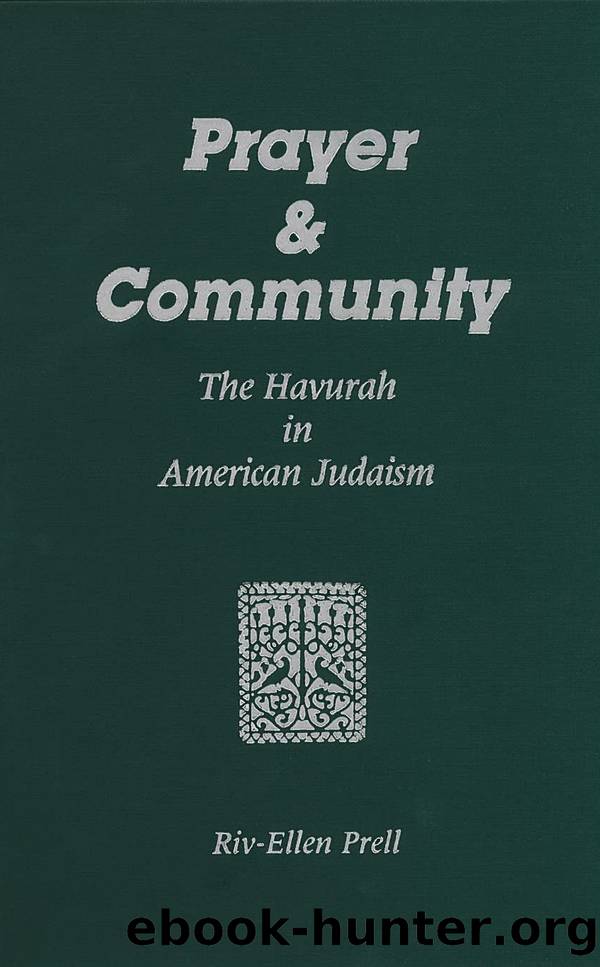Prayer & Community by Prell Riv-Ellen;

Author:Prell, Riv-Ellen;
Language: eng
Format: epub
Publisher: Wayne State University Press
Published: 2017-06-23T00:00:00+00:00
Minyan Prayer Forms: Community
Through prayer Minyan members interacted, and, in turn, their prayer was affected by those interactions. Because public Jewish prayer requires a minyan, it was an inherently appropriate vehicle for community. The Minyanâs desire to create an alternative to the synagogue arose out of their intense interest in truly communal prayer. They all valued forms of prayer that intensified community. They sang prayers together, prayed aloud to be heard by one another, arranged their prayer space, and moved their bodies while praying in a way that made them visible to one another. The Minyan sought to achieve an experience of prayer that was nonunison, yet still synchronized. That type of prayer has been compared to jazz, with its emphasis on improvisation within unity (Heilman, 1983). The strongly communal aspect of Jewish prayer is illustrated by the fact that if an individual prays alone, he or she should attempt to pray at the same time the synagogue does, using the same liturgy, except for those prayers that require the quorum. Prayer is not only prayed within a community, it takes a communal form in the use of some plural language, and its subject often concerns the community. Hence, the first constituent of Minyan prayer is that it is public and communal.
No one in the Minyan was clearer in defining the communal basis of prayer life than Saul, a college student in his early twenties. He was a member of the group for less than a year in 1973, but had prayed regularly his entire life. As a Jewish educator and a child of a Conservative rabbi, he had grown up with considerable consciousness of what prayer should be like and how to achieve that end. I asked Saul if he prayed to someone, and his answer emphasized the connection between prayer and community.
You mean God? No. Do you mean is someone in the Minyan listening to me? Thatâs pretty important. I like the feeling that other people are being affected by my mood in their prayers. The people who sit around me when we pray can tell my mood and concentration. People look to see if other people are concentrating. If a lot of people are, it helps me to concentrate. And when I am hazan I want to mobilize something thatâs going on in the group and get that in synch with the prayers that I particularly like and find powerful.
He articulated how closely people were linked in the community through prayer, even though they prayed individually for the majority of the service. Prayer could be, and often was, tied to the moods and emotions of participants. To listen to others praying was part of prayer. In this sense prayer was quite appropriate to the articulation of communal sentiments. The halahic requirement of a quorum for prayer indicates that the tradition itself recognizes that community is an integral part of the prayer experience. Mark explained to me how he understood the relationship to others in prayer.
I need prayer to connect me to others.
Download
This site does not store any files on its server. We only index and link to content provided by other sites. Please contact the content providers to delete copyright contents if any and email us, we'll remove relevant links or contents immediately.
| Haggadah | Hasidism |
| History | Holidays |
| Jewish Life | Kabbalah & Mysticism |
| Law | Movements |
| Prayerbooks | Sacred Writings |
| Sermons | Theology |
| Women & Judaism |
The Secret Power of Speaking God's Word by Joyce Meyer(2750)
Man's Search for Meaning by Viktor E. Frankl(2555)
Mckeown, Greg - Essentialism: The Disciplined Pursuit of Less by Mckeown Greg(2333)
MOSES THE EGYPTIAN by Jan Assmann(2275)
Devil, The by Almond Philip C(2204)
Unbound by Arlene Stein(2179)
The Complete Dead Sea Scrolls in English (7th Edition) (Penguin Classics) by Geza Vermes(2135)
I Capture the Castle by Dodie Smith(1905)
Schindler's Ark by Thomas Keneally(1759)
The Invisible Wall by Harry Bernstein(1706)
The Gnostic Gospel of St. Thomas by Tau Malachi(1677)
The Bible Doesn't Say That by Dr. Joel M. Hoffman(1608)
The Secret Doctrine of the Kabbalah by Leonora Leet(1526)
Political Theology by Carl Schmitt(1501)
The Jewish State by Theodor Herzl(1470)
A History of the Jews by Max I. Dimont(1439)
The Dead Sea Scrolls Bible by Martin G. Abegg(1425)
The Book of Separation by Tova Mirvis(1419)
Oy!: The Ultimate Book of Jewish Jokes by David Minkoff(1293)
